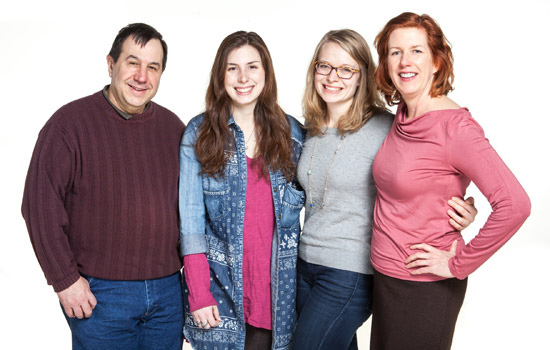Explore connection between music, audience
Sound ExChange: Interactive Music & Visual Art set for Student Innovation Hall
Dan Wang
RIT professor Joe Geigel, left, new media design student Katie Verrant, Sound ExChange Executive Director Emily Wozniak, and RIT professor Susan Lakin are preparing an interactive concert for Imagine RIT.
Organizers of the Sound ExChange exhibit are aiming to turn Imagine RIT festivalgoers’ heads with a live performance inside Student Innovation Hall with two collaborative projects featuring the Sound ExChange with RIT faculty and students.
The May 3 workshop is designed to explore the connection between audience members and musicians. The Sound ExChange: Interactive Music & Visual Art exhibit will present two collaborations between Sound ExChange, an ensemble of Eastman School of Music musicians, together with faculty and students from RIT’s College of Imaging Arts and Sciences and the B. Thomas Golisano College of Computing & Information Sciences.
In the first musical number, Sound ExChange—under the direction of Emily Wozniak, executive director—will perform with work by W. Michele Harris, GCCIS associate professor. The second program will feature a new collaboration using imagery, motion capture and mobile devices. The exhibit will initiate a “conversation” between musician and audience that will continue throughout the course of the musical program. Festivalgoers will be invited to join in the conversation by using a specially designed mobile app that will be available for download prior to the performance.
The performance begins at 2 p.m. and will run approximately one hour. In addition, 30 minutes will be dedicated after the performance for attendees to engage with musicians, artists, programmers and the technology employed during the show.
The Imagine RIT workshop will provide the first public opportunity to engage a live audience with the collaboration’s many months of hard work.
“We want this to be a multi-sensory performance,” said Susan Lakin, associate professor and program chair of advertising photography. “Sound ExChange’s mission is to redefine classical music in the 21st century and we want people to not only hear wonderful live music, but have a visual and interactive experience.”
Geigel, associate professor of computer science, likened it to “a transformative collaboration between the worlds of live music and technology.”
“We’ve been using this semester as a test bed for (GCCIS) students to come up with some really innovative ideas and develop the technical infrastructure necessary to facilitate communication between the audience and the musicians,” Geigel said. “We’re designing ways for people to use their mobile devices during the performance to initiate a real-time conversation between the musicians and the audience.”
Imagine RIT also will serve as a “beta” event for a public concert series beginning in September, including an educational component and online presence.
Katie Verrant, a third-year new media design major, is serving as the project designer.
“Collaboratively we all came up with the ideas and my main job has been to figure out the interface design behind them,” said Verrant, originally from the San Francisco area before graduating high school in New Hope, Pa. “For the Imagine festival, I have been working closely with one of the musicians to design the audience-interaction visuals and a motion-graphics video for his musical composition.”
“They are fun, energetic and a great group of people to work with,” Verrant added. “If you want to have a great time out and not just sit and listen to music, go see Sound ExChange perform somewhere.”
And while people can bring music anywhere with today’s ubiquitous technology, Lakin said it can’t replace the real thing.
“We’re consuming music so much today on our mobile devices, but nothing replaces the live performance,” Lakin said.













